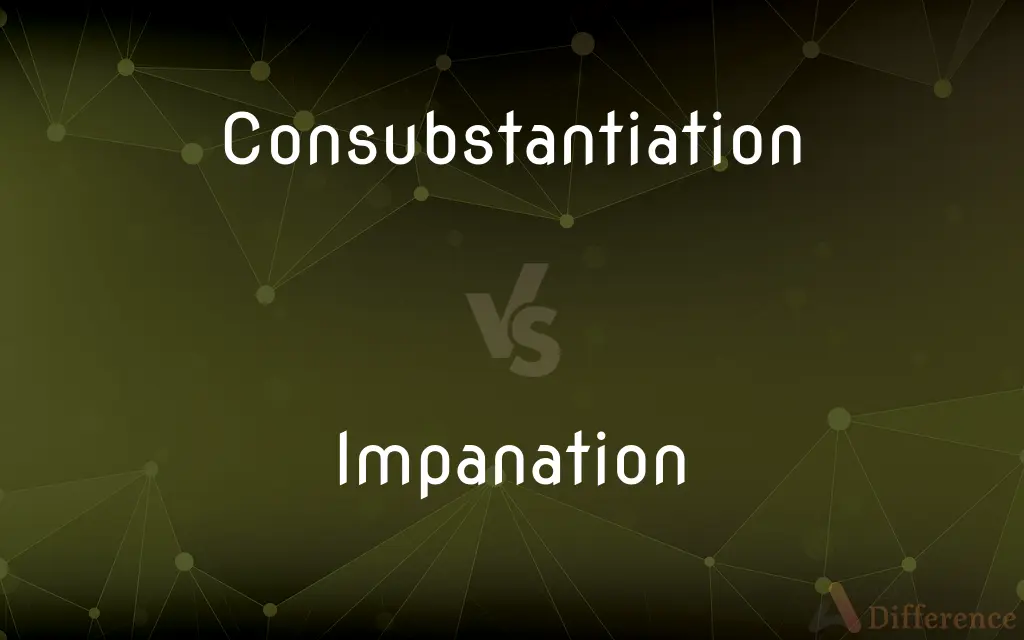Consubstantiation vs. Impanation — What's the Difference?
Edited by Tayyaba Rehman — By Fiza Rafique — Updated on April 26, 2024
Consubstantiation is the theological belief that Christ's body and blood coexist with bread and wine during Eucharist, whereas impanation posits that the body of Christ is literally in the bread.

Difference Between Consubstantiation and Impanation
Table of Contents
ADVERTISEMENT
Key Differences
Consubstantiation, a term often associated with Lutheran theology, suggests that during the Eucharist, the substances of Christ's body and the substances of bread and wine simultaneously exist together without conversion of the substances. Whereas, impanation, a less common theological concept, involves the actual physical incorporation of Christ’s body into the bread itself.
In consubstantiation, the physical elements of bread and wine remain fundamentally unchanged, maintaining their original properties, while also being joined with Christ's body. On the other hand, in impanation, the bread is transformed into a new entity that literally contains the body of Christ, implying a change or union at the material level.
The concept of consubstantiation does not imply a permanent change in the elements of the Eucharist, which revert to their ordinary substance after the sacrament. Conversely, impanation suggests a more permanent embedding of Christ’s body within the bread, which may imply a lasting sanctity to the bread itself.
The theological implications of consubstantiation affirm the presence of Christ in the Eucharist as real and substantial but symbolically united with the bread and wine. Impanation, however, leans towards a more literal and physical interpretation, suggesting a real, tangible change in the bread’s essence.
These differing views impact the theological understanding and the practice of the Eucharist, where consubstantiation supports a more symbolic and sacramental union, enhancing the spiritual experience without asserting a change in the essence of the elements. In contrast, impanation provides a more mystical and incarnational approach to the presence of Christ in the Eucharist.
ADVERTISEMENT
Comparison Chart
Definition
Coexistence of Christ's body with bread and wine
Literal incorporation of Christ’s body into bread
Change in Elements
No change in essence, only coexistence
Change in the bread to contain Christ’s body
Theological Basis
Lutheran theology, symbolic presence
Less common, emphasizes physical presence
Duration of Change
Temporary during Eucharist
Implies a more permanent change
Spiritual Implication
Symbolic and sacramental union
Mystical and incarnational approach
Compare with Definitions
Consubstantiation
The coexistence of Christ's body and blood with bread and wine during Eucharist without substance transformation.
In consubstantiation, the bread and wine are spiritually and substantially united with Christ yet remain bread and wine.
Impanation
A theological view where Christ’s body is believed to be literally embedded in the Eucharist bread.
Impanation treats the bread as a literal container of Christ’s body.
Consubstantiation
A concept used to describe the Eucharistic presence in some Protestant churches.
Some Anglican theologians adopt views similar to consubstantiation regarding the Eucharist.
Impanation
Belief in the physical and permanent alteration of bread to embody Christ.
The doctrine of impanation suggests a mystical transformation of the Eucharist bread.
Consubstantiation
Theological stance where divine and earthly substances coexist.
Consubstantiation teaches that Jesus is genuinely present in the Eucharist, coexisting with the bread and wine.
Impanation
Emphasizes a physical union between Christ’s body and the bread.
In impanation, the bread used in Eucharist becomes an actual part of Christ’s body.
Consubstantiation
A doctrine focusing on the non-conversion of bread and wine into body and blood.
Unlike transubstantiation, consubstantiation holds that the bread maintains its nature.
Impanation
Viewed as a form of the real presence in certain Christian sects.
Some Christian sects view impanation as a deep manifestation of Christ’s incarnation in the Eucharist.
Consubstantiation
A Lutheran belief emphasizing the real presence of Christ in the Eucharist.
Consubstantiation underscores a sacramental union in the Eucharist, distinct from transubstantiation.
Impanation
Rare theological concept focusing on a tangible presence in the Eucharist.
Impanation is less commonly accepted than other interpretations of Christ’s presence.
Consubstantiation
An identity or union of substance.
Impanation
Impanation (Latin: impanatio, "embodied in bread") is a high medieval theory of the real presence of the body of Jesus Christ in the consecrated bread of the Eucharist that does not imply a change in the substance of either the bread or the body. This doctrine, apparently patterned after Christ's Incarnation (God is made flesh in the Person of Jesus Christ), is the assertion that "God is made bread" in the Eucharist.
Consubstantiation
(Christianity) The actual, substantial presence of the body of Christ with the bread and wine of the sacrament of the Lord's Supper; impanation, as opposed to transubstantiation.
Impanation
(Christianity) The actual, substantial presence of the body of Christ with the bread and wine of the sacrament of the Lord's Supper — as opposed to transubstantiation.
Consubstantiation
An identity or union of substance.
Consubstantiation
The actual, substantial presence of the body of Christ with the bread and wine of the sacrament of the Lord's Supper; impanation; - opposed to transubstantiation.
Common Curiosities
Is consubstantiation accepted by all Lutheran churches?
While widely associated with Lutheran theology, consubstantiation is not universally or explicitly adopted as a doctrine by all Lutheran churches.
How do consubstantiation and impanation impact the understanding of the Eucharist's sacramental nature?
Consubstantiation views the Eucharist as a sacramental union where Christ is present symbolically and substantially, while impanation sees it as a mystical and physical incorporation, affecting the perceived reality and presence of Christ in the sacrament.
How does the belief in consubstantiation affect the liturgical practices in churches?
In churches that hold to consubstantiation, the Eucharist is treated with high reverence as it is believed to contain both the spiritual and physical presence of Christ, although the elements themselves are not permanently transformed, impacting how they are handled and disposed of during communion services.
Can impanation be considered orthodox in mainstream Christianity?
Impanation is generally not considered an orthodox belief in mainstream Christianity, which typically adheres to more established doctrines like transubstantiation (Catholicism) or symbolic presence (many Protestant denominations).
What is consubstantiation?
Consubstantiation is a theological belief that Christ’s body and blood coexist with the bread and wine during the Eucharist without transforming the substance of the bread and wine.
How does impanation differ from consubstantiation?
Impanation involves a belief that Christ’s body is literally incorporated into the bread of the Eucharist, unlike consubstantiation, which holds that Christ's body and the elements coexist.
What are the implications of impanation for the sanctity of the Eucharist bread?
Impanation implies that the Eucharist bread, transformed to contain Christ’s body, carries a permanent sanctity, requiring reverential handling and disposal.
What historical context gave rise to the doctrine of consubstantiation?
Consubstantiation arose primarily as a Reformation response to the Catholic doctrine of transubstantiation, offering an alternative understanding of Christ’s presence in the Eucharist that differed from the Catholic transformation of substance while maintaining a real presence.
Which denominations are known to hold the belief in impanation?
Impanation is not widely held among mainstream Christian denominations and is more often found in certain esoteric or mystical Christian groups who emphasize a very literal interpretation of Christ's presence in the Eucharist.
What theological controversies surround consubstantiation and impanation?
Consubstantiation has been a point of contention between Lutherans and other Protestant groups who view the Eucharist as merely symbolic. Impanation faces even greater theological scrutiny and debate due to its very literal and less widely accepted view of Christ’s presence in the Eucharist, leading to discussions about the interpretation of scripture and the nature of the sacraments.
Share Your Discovery

Previous Comparison
Nonpaginated vs. Paginated
Next Comparison
Inevitable vs. InexorableAuthor Spotlight
Written by
Fiza RafiqueFiza Rafique is a skilled content writer at AskDifference.com, where she meticulously refines and enhances written pieces. Drawing from her vast editorial expertise, Fiza ensures clarity, accuracy, and precision in every article. Passionate about language, she continually seeks to elevate the quality of content for readers worldwide.
Edited by
Tayyaba RehmanTayyaba Rehman is a distinguished writer, currently serving as a primary contributor to askdifference.com. As a researcher in semantics and etymology, Tayyaba's passion for the complexity of languages and their distinctions has found a perfect home on the platform. Tayyaba delves into the intricacies of language, distinguishing between commonly confused words and phrases, thereby providing clarity for readers worldwide.














































